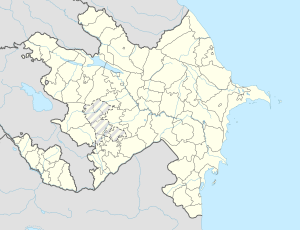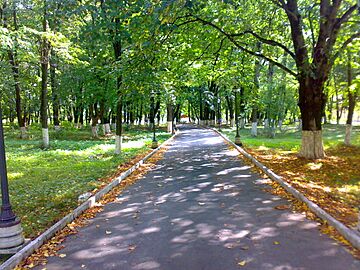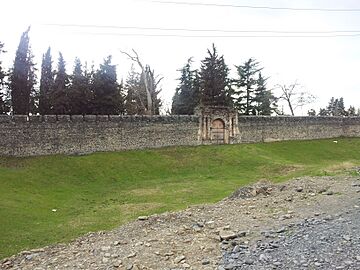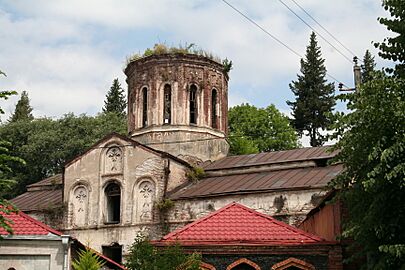Zaqatala (city) facts for kids
Quick facts for kids
Zaqatala
Закатала / Чlaр
Гал |
|
|---|---|
|
City & Municipality
|
|
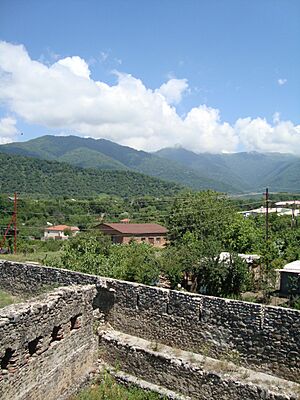
Nature of Zaqatala
|
|
| Country | |
| District | Zagatala |
| Elevation | 518 m (1,702 ft) |
| Population
(2020)
|
|
| • Total | 32,171 |
| Time zone | UTC+4 (AZT) |
Zaqatala (Azerbaijani: Zaqatala, Avar: Закатала / Чӏар, Tsakhur: Гал) is a lively city in northwestern Azerbaijan. It is the main city of the Zagatala District. About 32,000 people live here, and the city sits right on the Tala River. Zaqatala includes the main city and a nearby village called Qazangül.
Most people in Zaqatala are Azerbaijanis. But there are also many people from other groups. These include the Avar, Lezgin, Tsakhur, and Ingiloy peoples.
Contents
A Look at Zaqatala's Past
Early History and Education
Long ago, the area where Zaqatala is now was part of an ancient land called Caucasian Albania. Later, it became a separate kingdom. This kingdom was strongly connected to the Georgian culture and politics. During the Middle Ages, this region, known as Saingilo, was mostly controlled by the kingdom of Georgia and Shirvan.
In the Middle Ages, there were seven Georgian schools in Saingilo. These schools taught important subjects like theology, philosophy, and history. They played a big part in sharing culture and knowledge among the different groups in the Caucasus region.
Historic Landmarks and Events
Zaqatala has many interesting historical places. Most of them are in the city center, which was built in the 1800s. In the main square, you can see two huge plane trees that are about 700 years old!
The most famous landmark is a ruined fortress. It was built in the 1830s by Russian forces. They used it to protect the city during the Caucasian War. In the 1850s, battles happened here between the Russians and a leader from Dagestan named Imam Shamil.
Later, in the 1900s, this fortress became famous for another reason. It was used as a prison for some sailors from the battleship Potëmkin. These sailors had rebelled during the 1905 Revolution. Today, the fortress still has a military base and some apartment buildings. Near the fortress, there's also a beautiful, old church that is no longer used. The city also has a large, new mosque.
Exploring Zaqatala Today
Nature and Outdoor Activities
Zaqatala is connected by the A315 road, which goes from Mingachevir to the Georgian border. There's also a small airport. North of the city, you'll find an important wildlife and nature preserve. The Caucasus Mountains protect the city from cold northern winds. The mountains are covered with forests and have many waterfalls. This makes them perfect for hiking and exploring nature. Because of its pleasant weather, Zaqatala is also a popular mountain health resort.
You can find several hotels in Zaqatala and in nearby villages. These include Ashaghi Tala and Jar, which are both close to the city.
Sports in Zaqatala
Zaqatala is home to two professional football teams: Simurg and Zagatala PFK. The Zaqatala City Stadium is located in the Galaduzu area. It opened in 2008 and is part of the Zagatala Olympic Sports Complex. The stadium can hold up to 3,500 people.
People of Zaqatala
Diverse Communities
Most of the people living in Zaqatala city and its district are Azerbaijanis. However, there are also many people from other groups. These include Avars, Lezgins, Tsakhurs, and Ingiloys. Most of the people are Sunni Muslim. There are also some Orthodox Christians, mainly from the Ingiloy group.
Getting Around Zaqatala
Travel Options
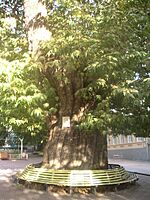
The Zaqatala International Airport serves the city. You can take a bus from the airport to the city center. There used to be flights to Baku, the capital, but they are not available right now.
Zaqatala has two bus stations. One is in the city center, close to the Farmer's Market. This station serves only the villages around Zaqatala. The second bus station is outside the city center. From here, you can take buses to other cities and to the capital. You can buy tickets directly at the bus station. You can reach this bus station by public transport or by taxi. There is also a railway station in Zaqatala. You can take a 12-hour train ride from Zaqatala to Baku.
Zaqatala's Weather
Zaqatala has a humid subtropical climate. This means it has hot, humid summers and mild winters.
| Climate data for Zaqatala (1971–1990, extremes 1952–1994) | |||||||||||||
|---|---|---|---|---|---|---|---|---|---|---|---|---|---|
| Month | Jan | Feb | Mar | Apr | May | Jun | Jul | Aug | Sep | Oct | Nov | Dec | Year |
| Record high °C (°F) | 20.0 (68.0) |
23.9 (75.0) |
27.8 (82.0) |
31.1 (88.0) |
36.1 (97.0) |
36.1 (97.0) |
38.9 (102.0) |
38.9 (102.0) |
37.2 (99.0) |
32.8 (91.0) |
25.0 (77.0) |
22.8 (73.0) |
38.9 (102.0) |
| Mean daily maximum °C (°F) | 5.3 (41.5) |
6.3 (43.3) |
11.2 (52.2) |
18.8 (65.8) |
22.2 (72.0) |
26.8 (80.2) |
30.5 (86.9) |
29.3 (84.7) |
25.7 (78.3) |
18.8 (65.8) |
12.5 (54.5) |
7.9 (46.2) |
17.9 (64.2) |
| Daily mean °C (°F) | 1.1 (34.0) |
2.3 (36.1) |
5.8 (42.4) |
12.7 (54.9) |
17.0 (62.6) |
20.9 (69.6) |
24.6 (76.3) |
23.7 (74.7) |
19.8 (67.6) |
13.5 (56.3) |
7.9 (46.2) |
3.2 (37.8) |
12.7 (54.9) |
| Mean daily minimum °C (°F) | −1.9 (28.6) |
−1.1 (30.0) |
2.7 (36.9) |
8.0 (46.4) |
12.0 (53.6) |
16.1 (61.0) |
19.4 (66.9) |
18.6 (65.5) |
15.0 (59.0) |
9.4 (48.9) |
4.6 (40.3) |
0.4 (32.7) |
8.6 (47.5) |
| Record low °C (°F) | −22.8 (−9.0) |
−13.9 (7.0) |
−12.2 (10.0) |
−3.9 (25.0) |
1.1 (34.0) |
6.1 (43.0) |
8.9 (48.0) |
7.8 (46.0) |
2.2 (36.0) |
−5.0 (23.0) |
−7.8 (18.0) |
−18.9 (−2.0) |
−22.8 (−9.0) |
| Average precipitation mm (inches) | 35 (1.4) |
52 (2.0) |
67 (2.6) |
78 (3.1) |
115 (4.5) |
129 (5.1) |
64 (2.5) |
75 (3.0) |
65 (2.6) |
106 (4.2) |
72 (2.8) |
33 (1.3) |
891 (35.1) |
| Average precipitation days | 7 | 8 | 11 | 12 | 13 | 10 | 7 | 7 | 7 | 9 | 8 | 7 | 106 |
| Mean monthly sunshine hours | 114.3 | 103.8 | 130.0 | 176.7 | 215.6 | 261.0 | 274.8 | 255.3 | 220.2 | 157.8 | 130.5 | 110.2 | 2,150.2 |
| Source 1: NOAA | |||||||||||||
| Source 2: Sistema de Clasificación Bioclimática Mundial | |||||||||||||
Gallery
See also
 In Spanish: Zagatala para niños
In Spanish: Zagatala para niños


